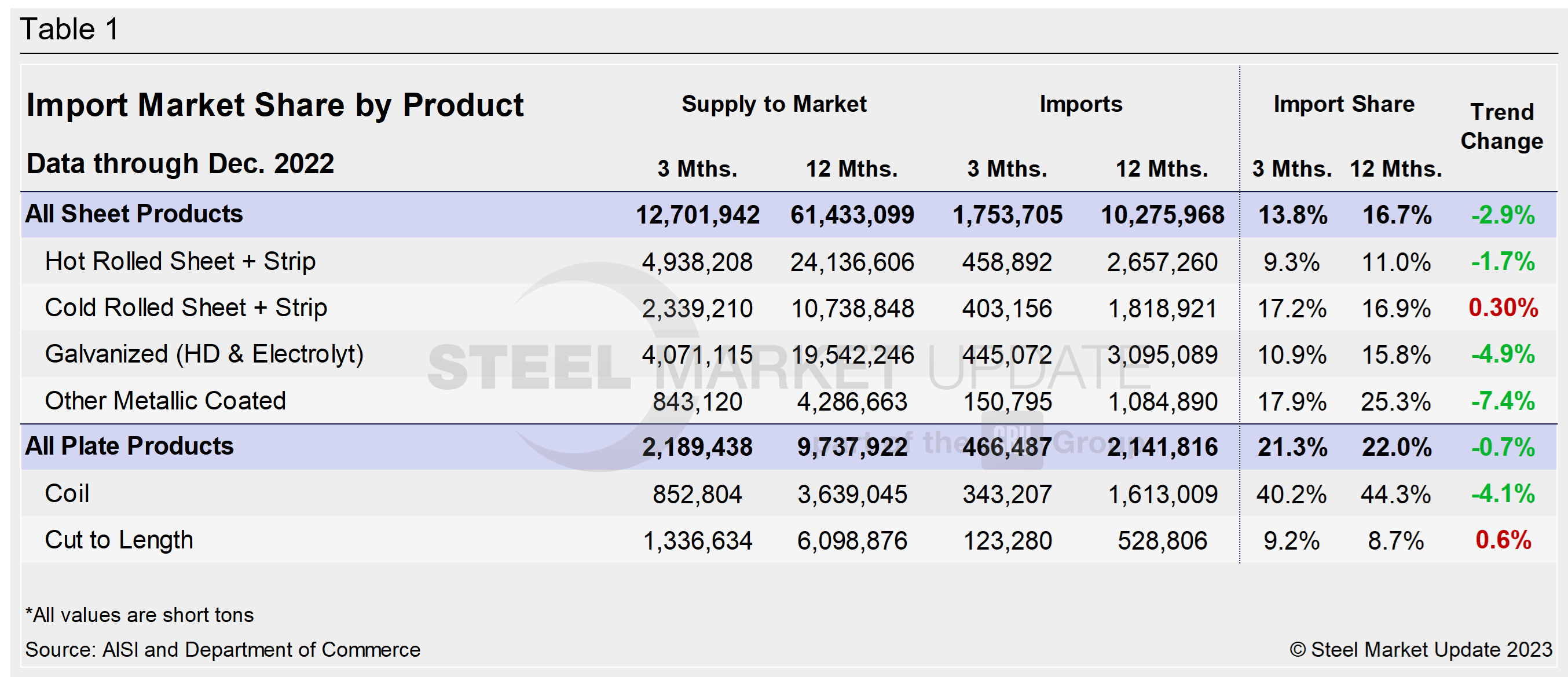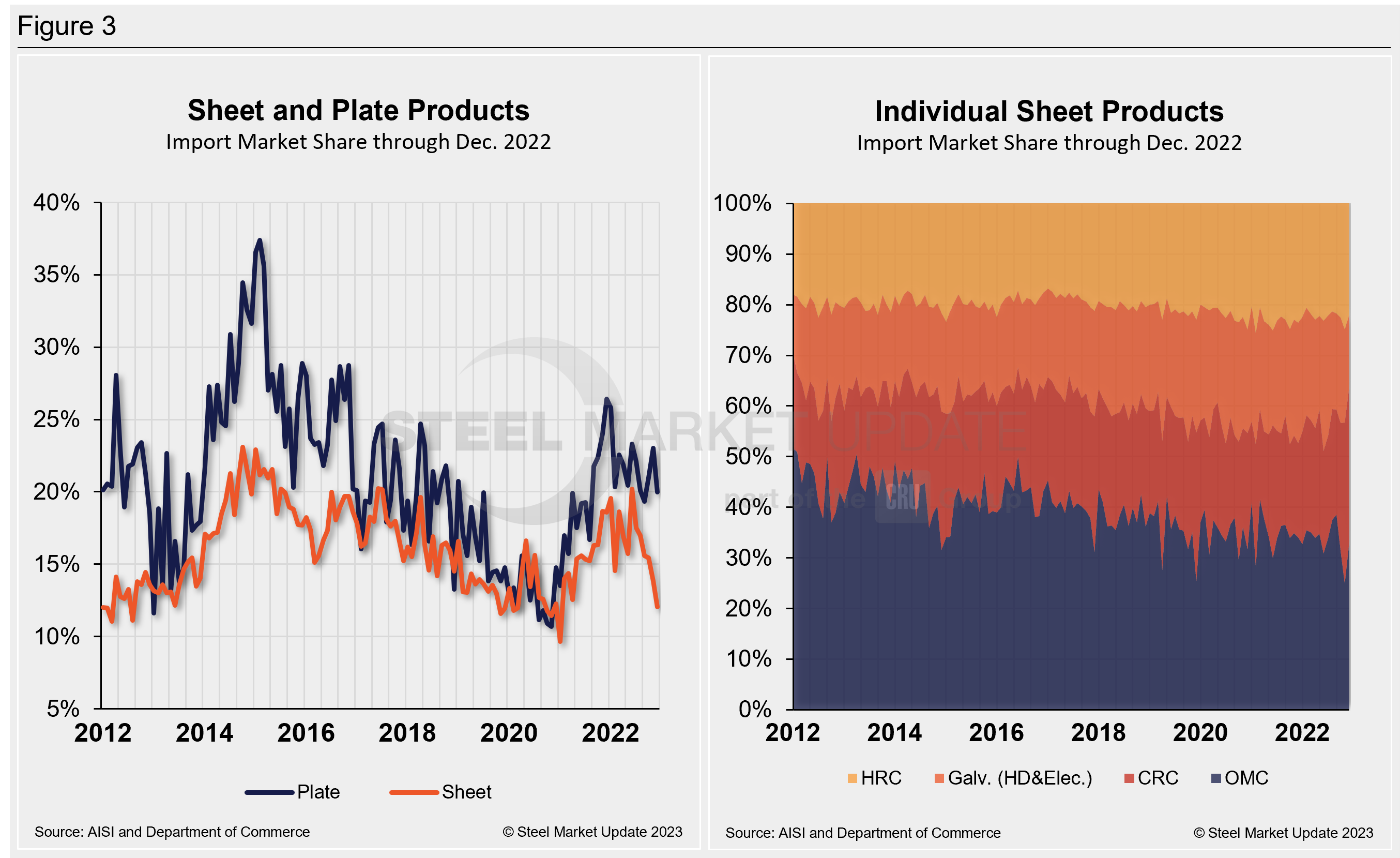Economy
December Import Share of US Sheet and Plate Markets
Written by David Schollaert
February 22, 2023
Imported sheet and plate products’ arrival at US ports declined in December, leading their share of the US markets to edge lower, while domestic shipments gained ground during the month.
That’s according to a Steel Market Update analysis of import data from the US Commerce Department and domestic shipment figures from the American Iron and Steel Institute (AISI).
Imports’ share of US sheet and plate markets peaked nearly a year ago, with sheet reaching its highest level in the past four-plus years. The trend was driven by buyers seeking relief from soaring domestic steel prices. Imports have fluctuated since, especially given the price cut seen for domestic steel. That downward trend somewhat accelerated through the second half of 2022 due to a tighter competitive edge vs. imports.
Imports’ share of total sheet shipments in the US was 12% in December, down from 13.8% in November, and falling for the sixth straight month. The decline was driven by a 14.2% drop in foreign sheet arrivals, while domestic sheet shipments edged up just 0.4% month on month (MoM). The market share of plate product imports also declined, down to 20% from to 23% the month prior, driven by a 9.9% decrease in foreign plate products and a 7.8% increase in domestic shipments.
December’s sheet imports totaled 492,837 tons, down from 686,216 tons in November. Overall domestic sheet product shipments were up to 3.59 million tons from 3.58 million tons.
Overall sheet products (domestic shipments plus imports) totaled 4.09 million tons in December, down from 4.16 million tons in November.
Hot-rolled coil (HRC) imports slipped 1.9% MoM in December, totaling 139,931 tons vs. 161,043 tons in November. Domestic shipments of HRC were up 8.5%, or 119,996 tons more, MoM. The details are below in Figure 1.

The import share of HRC decreased, down 1.9 percentage points to 8.3% in December, the second lowest total all year, and well below the recent high of 15.3% set in October 2021. The decreased share was driven in part by a 13.1% decline in the arrival of foreign material, while domestic shipments trended at 8.5%. HRC apparent supply totaled 1.68 million tons in December, up from 1.58 million tons the month prior.
Cold-rolled coil (CRC) imports dipped by 6.2% in December, while galvanized (hot dipped and electrolytic) fell 29.8% over the same period. Other metallic coat (OMC) jumped 29.7% MoM.
Plate products in December saw another overall increase in shipments as apparent supply edged up by 3.7% MoM. The increase was driven by a boost of 7.8% in domestic plate shipments, while imports fell by 9.9% MoM. With the decrease, plate imports were among some of the lowest totals for the year at 149,650 tons.
All told, total plate shipments, including foreign and domestic, were 748,821 tons in December, up from 721,999 tons the month prior.
The import market share for plates in coil declined to 39.6% in December, a 2.6-percentage-point decrease MoM. The decline in market share was driven by an 18.6% increase in domestic shipments, even though foreign product arrival increased by 6.6% over the same period. Total imports of plates in coil were 123,530 tons in December, up from November’s 115,897 tons.
The table below displays the total supply to the market in three months and 12 months through December 2022 for sheet and plate products and six subcategories. Supply to the market is the total of domestic mill shipments plus imports. It shows imports on the same three- and 12-month basis and then calculates import market share for the two time periods for six products. Finally, it subtracts the 12-month share from the three-month share. Increasing import market share is in red. Decreasing import market share is in green.

The big picture: imports’ share of US sheet and plate sales remain down through December. The big second-half jump in total imports in 2021 was the result of historically and disproportionately high domestic steel prices. The influx of foreign material has declined considerably on sharply lower domestic prices.
Except for cut-to-length plate, and cold rolled, the remaining sheet and plate products have seen a trend shift, illustrating how import competition is no longer impacting domestic products in three months compared to 12 months. The most notable of those subcategories are galvanized (HD & electrolyt) and other metallic coated products, which have both seen declining import market shares through December.
The import market share of individual plate products and a breakdown of the market share for plates in coil are displayed together in Figure 2.

The historical import market share of plate and sheet products, and the import market share of the four major sheet products, are shown side by side in Figure 3.

By David Schollaert, david@steelmarketupdate.com

David Schollaert
Read more from David SchollaertLatest in Economy

Architecture billings continue to slide in March
Architecture firms said billings continued to decline in March, according to the latest Architecture Billings Index (ABI) released by the American Institute of Architects (AIA) and Deltek.

Beige Book shows concerns about trade policy
Manufacturing was mixed, but two-thirds of districts said activity was little changed or had declined.

New York state manufacturing index drops again in April
Firms were pessimistic, with the future general business conditions index falling to its second lowest reading in the more than 20-year history of the survey

Construction adds 13,000 jobs in March
The construction sector added 13,000 jobs, seasonally adjusted, in March, but tariffs could undermine the industry.

Supply chains, end-users brace for impact from tariffs
Supply chains are working through what the tariffs mean for them
